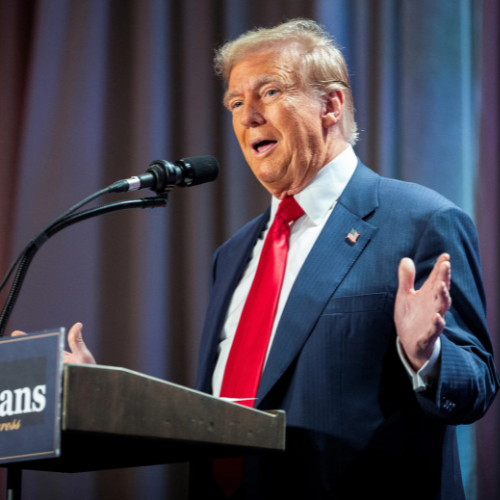President-elect Donald Trump announced a dramatic new plan to impose a 25% tariff on all goods coming into the United States from Mexico and Canada. This means that anything imported from these two neighboring countries—whether it’s cars, food, or other goods—will cost significantly more for American companies and possibly consumers.
Trump declared that this would be one of his first actions as president. He shared the announcement on his social media platform, stating that the tariffs are intended to address illegal immigration, drug smuggling, and what he called “ridiculous Open Borders.” According to him, these measures will remain in place until Mexico and Canada crack down on migrants and illegal drugs entering the U.S., especially fentanyl, a deadly synthetic opioid.
This decision has surprised many because it challenges the trade deal between the U.S., Mexico, and Canada, called the USMCA (United States-Mexico-Canada Agreement). This agreement, signed into law by Trump himself in 2020, was designed to make trade between these countries easier by reducing taxes and other trade barriers. Imposing these tariffs might go against the rules of that deal.
Mexico and Canada are the U.S.’s biggest trading partners. For example, in 2023, over 83% of Mexico’s exports and 75% of Canada’s exports went to the U.S. Experts say that disrupting this relationship could harm the economies of all three countries.
China Targeted with 10% Extra Tariffs
Trump didn’t stop with North America. He also announced an additional 10% tariff on products coming into the U.S. from China. This is in response to what he claims is China’s failure to stop the flow of drugs, especially fentanyl, which Trump says originates in China and reaches the U.S. through Mexico.
This tariff would be added on top of any existing tariffs already in place. For years, the U.S. and China have had a tense trade relationship, with tariffs being a key issue. During Trump’s first term as president, he imposed significant taxes on Chinese imports, but this new proposal would push those costs even higher.
China, which has been dealing with economic struggles like a property crisis and weakening consumer demand, has yet to respond officially to this announcement. The impact of these new tariffs could put more strain on their already fragile economy.
China Warns EU Over EV Tariffs: Retaliates with Dairy Product Probe
Trump has also hinted at imposing much higher tariffs on Chinese imports in the future, possibly up to 60% or more. He previously mentioned ending China’s “most-favored-nation” trading status, which allows for lower tariffs on certain goods.
Economic Shockwaves Around the World
The news of these tariffs has already caused ripples in global markets. The U.S. dollar rose sharply against the currencies of Mexico and Canada after the announcement. For example, the Mexican peso lost over 2% of its value, and the Canadian dollar dropped by 1%. These changes make Mexican and Canadian goods more expensive for Americans to buy.
Stock markets were also affected. In Japan, the Nikkei index fell by 1%, and U.S. stock futures—used to predict how the market will open—dropped by 0.3%. Economists say that imposing such high tariffs could raise prices for consumers in the U.S. and potentially lead to inflation. Companies that rely on imports from Mexico, Canada, or China would have to pay more, and these costs could be passed down to American buyers.
Trump has made it clear that he believes these tariffs will force countries to pay for what he sees as unfair trade practices and failures to stop illegal drugs. He also suggested that they would pay a “very big price” for not cooperating.
In the past, Trump has floated even more extreme ideas, such as tariffs as high as 200% on cars coming across the U.S.-Mexico border. He has also said that he plans to invoke a review of the USMCA in 2026, which could potentially lead to changes or even termination of the trade deal.
While governments in Mexico, Canada, and China have not yet issued official responses, the announcement has sparked widespread discussion. Trade experts and economists warn that these actions could lead to retaliation, disrupt supply chains, and have a massive impact on businesses and consumers alike.
These bold and controversial proposals are already stirring the pot, even before Trump officially takes office in January. While some applaud his hardline stance on trade and border security, others worry about the economic consequences of such aggressive measures. The world is now watching to see how these plans unfold.


